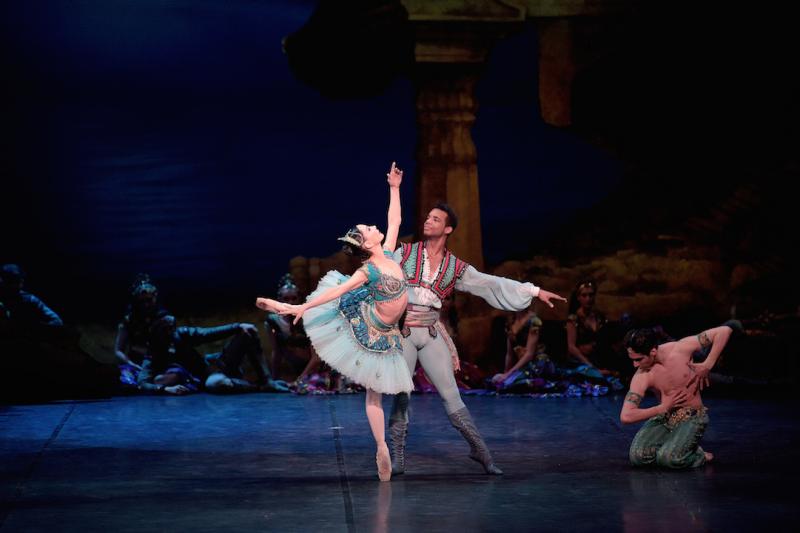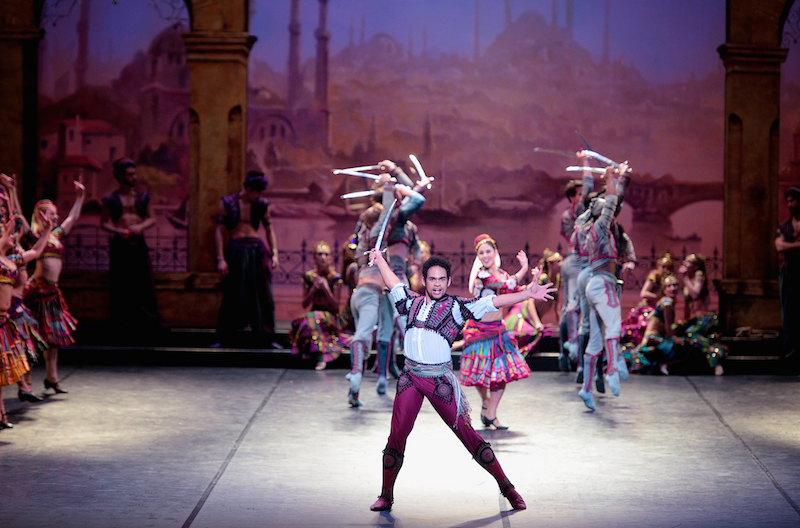Le Corsaire, English National Ballet, Coliseum | reviews, news & interviews
Le Corsaire, English National Ballet, Coliseum
Le Corsaire, English National Ballet, Coliseum
Spectacular dance fireworks make this hoariest and silliest of Russian classics worth seeing

It’s being sold as the ideal ballet for first-timers, but I would blush to introduce even my neighbour’s cat to this Carry On Up the Harem hokum. Worse, its silliness verges on offensive. When, in Rudolph Nureyev’s 1990s production of La Bayadère for Paris Opera Ballet, a chorus of blacked-up picaninnies appeared for about three minutes, you blinked and put it down to an unwise attempt at historical accuracy.
And yet it’s easy to see why the company’s dancers have taken this old warhorse to their hearts, and why Tamara Rojo – surely no slouch in the gender-politics department – thought fit to make Le Corsaire her first full-length commission. Unlike almost every other 19th-century ballet you can think of, it has great parts for men – OK, not great in terms of character development, but physically explosive. And if la Rojo’s artistic directorship, four years in, had to be characterised by one thing only, it would be her knack for finding and cultivating male talent. ENB is bursting with it, to the extent that the biggest cheers on opening night are for Junior Soloist Cesar Corrales, dancing the slave Ali with spectacular panache.
Forget anything you might know about Byron’s narrative poem of the same title. Act One of Corsaire has so little plot and ends on a note of such throwaway bathos that you wonder if something went wrong. Slave girls are salaciously roped together to be displayed for sale at a market, only for said slave girls, 30 seconds before the first curtain, to run away en masse. In refurbishing this production from the one she put together for American Ballet Theatre, that in turn built on a Soviet model, Anna-Marie Holmes might have taken the opportunity to fix this.
 So, the dancing’s the thing, and the dancing only, which makes it even more of a pity that Alina Cojocaru, scheduled to dance Medora but laid off by injury, has been replaced by Rojo for all her performances. Marvellous as it is that she manages to maintain her own dancing at the same time as running a company, Rojo would not be my ballerina of choice in this repertory. Cuban guest star Osiel Gouneo is her Conrad, a masterclass in how to command a stage and make sense of a silly part purely by believing in it. He has an appealing habit of appearing to take a long and lingering sniff at some mysterious perfume before launching into each of his solos, which only adds to the pantherish sensuality of his movement.
So, the dancing’s the thing, and the dancing only, which makes it even more of a pity that Alina Cojocaru, scheduled to dance Medora but laid off by injury, has been replaced by Rojo for all her performances. Marvellous as it is that she manages to maintain her own dancing at the same time as running a company, Rojo would not be my ballerina of choice in this repertory. Cuban guest star Osiel Gouneo is her Conrad, a masterclass in how to command a stage and make sense of a silly part purely by believing in it. He has an appealing habit of appearing to take a long and lingering sniff at some mysterious perfume before launching into each of his solos, which only adds to the pantherish sensuality of his movement.
The American Brooklyn Mack is the other high-flying guest, a demonic technician and beautiful to boot as the slave merchant Lankadem. ENB’s own Yonah Acosta makes a power-packed Birbanto, treacherous friend to Conrad, while Cesar Corrales, yet another Cuban, strips the paint from the floor with his scorchingly fast jetés as slave Ali, a character cursed to spend the rest of his stage time scurrying several paces behind everyone else. The second ballerina role of Gulnare belongs to Laurretta Summerscales, the fleetness of whose feet belie the lovely length of her limbs.
Tantalisingly, once or twice, you catch a strain of 'Giselle'’s sound world
Much has been made of the sets and costumes of Hollywood designer Bob Ringwood, and they are indeed good at summoning the generic “East” (Persia? Morocco? India?) of the 19th-century imagination, with nods to various European landscape painters of the time. As for staged shipwrecks, though, I’ve still seen nothing to beat the lurching realism of Lila de Nobili’s lo-tech 1958 designs for Frederick Ashton’s Ondine. And don’t expect Le Corsaire to send you out into the night humming the tunes, either. Not one of its 10 composers (yes, 10), managed to come up with anything memorable, though you do tantalisingly, once or twice, catch a strain of Giselle’s sound world in the contribution of Adolph Adam.
In the same way, you clutch at the coat-tails of Imperial choreographer Marius Petipa, whose stamp is still visible in a couple of the set pieces. One of these is the traditional vision scene, the so-called Jardin animé, danced very nicely by ENB’s corps with added children clad in pastel turbans. To get the effect originally intended, though, you’d need a corps of treble that size. And since this production does insist on trying to show us that this vision is the result of a bong-smoking session, Michael Coleman, hamming it up shamelessly as the randy old Pasha, will have to make it more obvious. The lighting could play its part too. With top ticket prices at the Coli now approaching Covent Garden levels (officially £102 for this, though discounts abound), there’s no excuse.
See this show for the circus fireworks, but don’t expect to be moved or enlightened.
Le Corsaire is at the Coliseum until January 24
rating
Explore topics
Share this article
The future of Arts Journalism
You can stop theartsdesk.com closing!
We urgently need financing to survive. Our fundraising drive has thus far raised £33,000 but we need to reach £100,000 or we will be forced to close. Please contribute here: https://gofund.me/c3f6033d
And if you can forward this information to anyone who might assist, we’d be grateful.

Subscribe to theartsdesk.com
Thank you for continuing to read our work on theartsdesk.com. For unlimited access to every article in its entirety, including our archive of more than 15,000 pieces, we're asking for £5 per month or £40 per year. We feel it's a very good deal, and hope you do too.
To take a subscription now simply click here.
And if you're looking for that extra gift for a friend or family member, why not treat them to a theartsdesk.com gift subscription?
more Dance
 Help to give theartsdesk a future!
Support our GoFundMe appeal
Help to give theartsdesk a future!
Support our GoFundMe appeal
 Romeo and Juliet, Royal Ballet review - Shakespeare without the words, with music to die for
Kenneth MacMillan's first and best-loved masterpiece turns 60
Romeo and Juliet, Royal Ballet review - Shakespeare without the words, with music to die for
Kenneth MacMillan's first and best-loved masterpiece turns 60
 Vollmond, Tanztheater Wuppertal Pina Bausch + Terrain Boris Charmatz, Sadler's Wells review - clunkily-named company shows its lighter side
A new generation of dancers brings zest, humour and playfulness to late Bausch
Vollmond, Tanztheater Wuppertal Pina Bausch + Terrain Boris Charmatz, Sadler's Wells review - clunkily-named company shows its lighter side
A new generation of dancers brings zest, humour and playfulness to late Bausch
 Phaedra + Minotaur, Royal Ballet and Opera, Linbury Theatre review - a double dose of Greek myth
Opera and dance companies share a theme in this terse but affecting double bill
Phaedra + Minotaur, Royal Ballet and Opera, Linbury Theatre review - a double dose of Greek myth
Opera and dance companies share a theme in this terse but affecting double bill
 Onegin, Royal Ballet review - a poignant lesson about the perils of youth
John Cranko was the greatest choreographer British ballet never had. His masterpiece is now 60 years old
Onegin, Royal Ballet review - a poignant lesson about the perils of youth
John Cranko was the greatest choreographer British ballet never had. His masterpiece is now 60 years old
 Northern Ballet: Three Short Ballets, Linbury Theatre review - thrilling dancing in a mix of styles
The Leeds-based company act as impressively as they dance
Northern Ballet: Three Short Ballets, Linbury Theatre review - thrilling dancing in a mix of styles
The Leeds-based company act as impressively as they dance
 Best of 2024: Dance
It was a year for visiting past glories, but not for new ones
Best of 2024: Dance
It was a year for visiting past glories, but not for new ones
 Nutcracker, English National Ballet, Coliseum review - Tchaikovsky and his sweet tooth rule supreme
New production's music, sweets, and hordes of exuberant children make this a hot ticket
Nutcracker, English National Ballet, Coliseum review - Tchaikovsky and his sweet tooth rule supreme
New production's music, sweets, and hordes of exuberant children make this a hot ticket
 Matthew Bourne's Swan Lake, New Adventures, Sadler's Wells review - 30 years on, as bold and brilliant as ever
A masterly reinvention has become a classic itself
Matthew Bourne's Swan Lake, New Adventures, Sadler's Wells review - 30 years on, as bold and brilliant as ever
A masterly reinvention has become a classic itself
 Ballet Shoes, Olivier Theatre review - reimagined classic with a lively contemporary feel
The basics of Streatfield's original aren't lost in this bold, inventive production
Ballet Shoes, Olivier Theatre review - reimagined classic with a lively contemporary feel
The basics of Streatfield's original aren't lost in this bold, inventive production
 Cinderella, Royal Ballet review - inspiring dancing, but not quite casting the desired spell
A fairytale in need of a dramaturgical transformation
Cinderella, Royal Ballet review - inspiring dancing, but not quite casting the desired spell
A fairytale in need of a dramaturgical transformation

Add comment